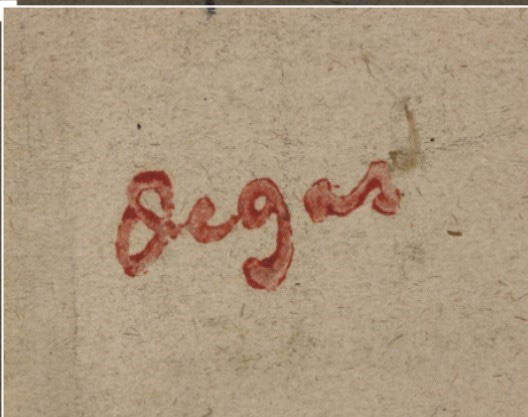Chapter 16, Sign Your Signature Like a Great Artist
From my upcoming new edition of The Art Studio Companion
Make Your Signature a Wonderful Finishing Touch to Your Painting
121 Vincent Van Gogh's signature.
In this study, we look at a couple of artists' signatures with the aim of developing our own special art signature.
One of the first things I teach students is to create their fine art signatures. It's different from signing a check; the signature says more about you and your art than you realize. A fine art signature should be unique to each artist, yet artistic. Often, I've seen paintings that suggest the artist was originally an architect (too slick), a designer (too flamboyant), a commercial artist (too generic), or an amateur (with a signature like B. Smith or Bob).
Mine is a little difficult because of the length; I economized the "e"s into diagonal dashes.
122 Edgar Degas's signature.
123 Edouard Manet's signature.
124 Michael Newberry's signature.
The reason I have them learn their special signature is because I want them to own their art. It prepares them to make an artwork that is special and meaningful to them.
Practice
As always, it is crucial to reinforce your understanding through practice.
First: Practice on a piece of paper. Instead of using a pencil or pen, use a brush with watercolor, ink, or acrylic paint.
Second: Use the fine art name you want to have for the rest of your life. For example, if you are a woman, you do not want to use Jones, get divorced, and then become Smith. Do not use your first name unless your last name is insanely long or unpronounceable. Van Gogh often used his first name, Vincent. Perhaps he did this because his last name is nearly impossible to pronounce correctly unless you are Dutch? “Gogh” begins and ends with guttural sounds that sound like coughing.
Third: With your brush and paint, use one or two marks for each letter. There are exceptions to this rule, for instance, Degas connected his “a” and “s.” Make each mark with new paint; it is not a scrawling signature in one go. Look at how Vincent signs the “n” in both places in his signature–they are beautifully made using two marks.
Fourth: Try to make your signature have hills and valleys like a landscape.
Fifth: No initials.
Sixth: Make about 25 signatures. Pick the one you love most.
Seventh: Use this signature to finish your painting.
Eighth: The color is up to you, but I love making my signature lighter than the background. It has to do with vibration: it is easier to add a lighter color to a painting than a darker one. If you are working in oil, a lighter signature looks especially good. If you are making a watercolor, then dark works great–the water medium gives a stain-glass-like glow.
Ninth: Do not sign things in the painting, like Van Gogh signed the pot. It becomes too cutesy. Just find a relatively empty space in any corner and sign it.
Tenth and Lastly: It should be just big enough to be clearly visible from about 15’ away. If you make a mistake, wipe it out, paint over the area in the painting’s original color, and then sign it again.
Your art signature should not be an afterthought. It should have the same level of intention that goes into your painting. Getting your signature right will delight you and inspire you to make your artworks worthy of it.






You have a nice signature, Newberry.
I am also thinking of Picasso's signature, which became looser and lazier and shorter as he aged. His signature seemed to evolve with his paintings.
Also, Rauschenberg's signature I have always loved. When he was much older and suffering from arthritis ( I think), He eventually took to using his actual thumbprint as a signature.
Anyways, artist's signatures is an interesting topic, and the way they evolve can be a clue (to something) illuminating.
Sent this to my granddaughter. She is a pretty good artist at 12 years old.